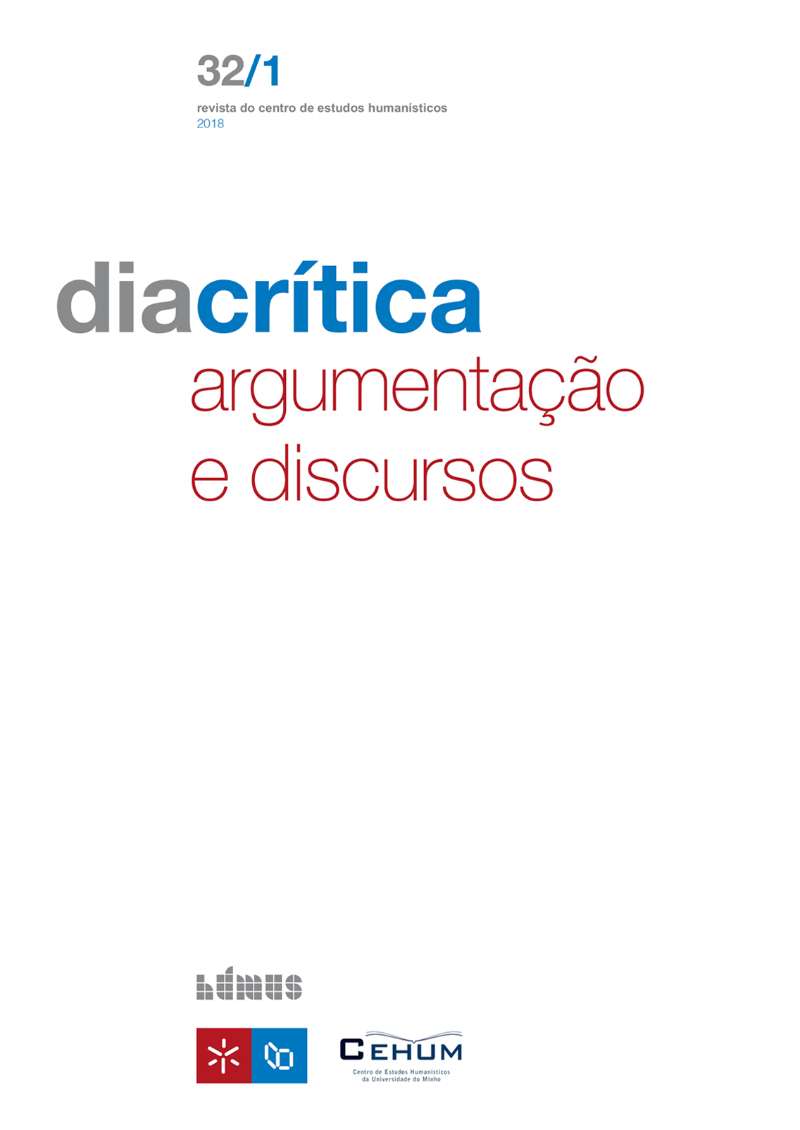Direct speech compounds in Brazilian Portuguese: fictive interaction in lexicon
DOI:
https://doi.org/10.21814/diacritica.5024Keywords:
direct speech compounds, fictivity, cognitive linguisticsAbstract
The aim of this article is to identify, describe and analyze the formal patterns and examples of Direct Speech Compounds (DSCs) in Brazilian Portuguese. DSCs consist of a noun (N) or a nominal phrase (SN) and a fictive direct speech modifier, as follows: “aliança eu escolhi esperar”, “dia do Fico”, “boquinha de moranguinho assim me sujei com morango, sabe?’’ e “maquiadoro” (adoro+ maquiagem). Our theoretical background is mainly based on Cognitive Linguistics authors such as Langacker (2008), Talmy (2000) and especially Pascual (2014; 2016). Methodologically, we have made an internet research on Google and we have found 44 DSCs occurrences inBrazilian Portuguese. The data analysis revealed four types of DSC patterns, in the following order of frequency: (i) N (P) + PREPOSITION “DE” + DIRECT SPEECHMODIFIER (ii) N(P) + DIRECT SPEECHMODIFIER, (III), N (P) + (PREPOSITION“DE’’) + HEDGE (TIPO) ASSIM + DIRECT SPEECH MODIFIER and (IV) NOUN +DIRECT SPEECH MORPHEME (in the same word). We claim that DSCs are a kindof lexicon-discourse blend in which the semantic noun elaboration, usually made by adjectives, are structured by the conversational frame, resulting in expressive effects such as humor, caricature, critic and persuasion.
References
Basílio, M. (2010). Fusão vocabular expressiva: um estudo da produtividade e da criatividade em construções lexicais.
Textos selecionados do XXV Encontro Nacional da Associação Portuguesa Linguística (pp. 201-210). Porto: APL. Disponível em: https://apl.pt/wp-content/uploads/2017/09/15-Margarida-Basilio.pdf. Acesso em 12/10/2018.
Bronzato, L.H. (2000). Inferências conversacionais e construções gramaticais: um processo sócio-cognitivo. Revista Instrumento, 2(1), 117-138. Disponível em: https://instrumento.ufjf.emnuvens.com.br/revistainstrumento/article/view/2567/1848. Acesso em 12/10/2018.
Dressler, W. (2006). Compound Types. In G. Libben & G. Jarema (Orgs), The Representation and Processing of Compound Words (pp.23-44). Oxford: Oxford University Press. Fauconnier, G. & Turner, M. (2002). The way we think. New York: Basic Books. Goffman, E. (1998). Footing. In B. Ribeiro, & P. Garcez (Orgs), Sociolinguística Interacional (pp. 70-97). Porto Alegre: AGE Editora. DOI: https://doi.org/10.1093/acprof:oso/9780199228911.003.0002
Gonçalves, C. A. & Almeida, M.L.L. (2007). Bases semântico-cognitivas para a diferenciação de cruzamentos vocabulares em português. Revista Portuguesa de Humanidades, 11, 75-85.
Hilpert, M. (2007). Chained metonymies in lexicon and grammar. A cross-linguistic perspective on body part terms. In G. Radden, K. Köpcke, T. Berg et al (Orgs), Aspects of meaning construction (pp. 77-98). Amsterdam: John Benjamins. DOI: https://doi.org/10.1075/z.136.07hil
Langacker, R. (1999). Virtual reality. Studies in the Linguistics Sciences, 29(2), 77-103. Disponível em: https://www.ideals.illinois.edu/bitstream/handle/2142/9679/
SLS1999v29.2-07Langacker.pdf?sequence=2 acesso em 12/10/2018.
Langacker, R. (2008). Cognitive Grammar. New York: Oxford University Press. DOI: https://doi.org/10.1093/acprof:oso/9780195331967.001.0001
Pascual, E. (2014). Fictive interaction. The conversation frame in thought, language, and discourse. Amsterdam: John Benjamins. DOI: https://doi.org/10.1075/hcp.47
Pascual, E. (2006). Fictive interaction within the sentence: a communicative type of fictivity in grammar. Cognitive Linguistics, 17(2), 245-267. DOI: https://doi.org/10.1515/COG.2006.006
Raso, T. & Mello, H. (2012). C-Oral Brasil: corpus de referência do português brasileiro falado informal. Belo Horizonte: UFMG.
Talmy, L. (2007). Attention phenomena. In H. Cuyckens & D. Geeraerts (Orgs), The handbook of Cognitive Linguistics
(pp. 264-293). New York: Oxford University Press.
Talmy, L. (2000). Fictive motion in language and “ception”. In L. Talmy (Org.), Toward a cognitive semantics, vol. 1 (pp. 125-162). Massachusetts: The MIT Press. DOI: https://doi.org/10.1163/9789004349575_005
Vachek, J. (1976). Selected Writings in English and General Linguistics. Prague: Academia. DOI: https://doi.org/10.1515/9783110803853
Downloads
Published
How to Cite
Issue
Section
License
Copyright (c) 2023 José Carlos da Costa Junior, Luiz Fernando Matos Rocha

This work is licensed under a Creative Commons Attribution-NonCommercial 4.0 International License.










